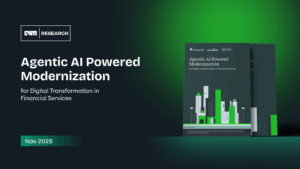In today’s dynamic business landscape, the integration of Generative AI within Software as a Service (SaaS) products has sparked a transformative wave. This synergy between AI capabilities and SaaS offerings has revolutionized how businesses operate and cater to their clientele. The amalgamation of Generative AI into SaaS products has not only enhanced operational efficiencies but also unlocked unprecedented opportunities for innovation and customer-centricity. This examination delves into the profound impact of Generative AI on SaaS solutions, exploring its role in optimizing workflows, personalizing user experiences, and ultimately driving business success.
We hosted a roundtable discussion along with leaders Sidd Tumkur, Senior Vice President, Data Strategy, Operations and Management at PURE Group of Insurance Companies, Patrick Bangert, SVP Data, Analytics and AI at Searce Inc, Padma Hari, XC Digital Officer and Gary Patel, Sr Director, eCommerce BI & Analytics at Albertsons to get more insights on this.
Exploring the Impact of Gen AI on SaaS Products: Perspectives from Industry Experts
In the contemporary landscape of technological advancement, General AI (Gen AI) is progressively emerging as an indispensable ally, enhancing the proficiency and capabilities of individuals across various domains. Many organizations’ current strategic vision is centered on harnessing the full potential of Gen AI to elevate operational effectiveness. We need to remember that Phase One of Gen AI deployments in organizations happens by Augmenting AI with the workforce. The key ROI of a Gen AI is efficiency.
A key focus area for many organizations is the exploration of Gen AI applications with Microsoft Co-pilot. This integration represents a significant foray into understanding and leveraging cutting-edge AI tools. Organizations are keenly investigating the potential synergies this can bring to day-to-day operations.
Furthermore, organizations are delving into the integration of Gen AI within the realm of Business Intelligence (BI) technologies. A critical aspect of this exploration involves examining the capability of BI solutions to address what are termed ‘prescriptive questions.’ This investigation aims to unearth insights into the underlying reasons behind specific data trends and anomalies, thereby enabling a more nuanced understanding of business challenges and opportunities.
Another significant area of focus is the potential integration of Gen AI for an organization in software development. By assisting developers in addressing coding challenges more efficiently, we aim to expedite the software development process. However, this venture is not without its challenges, primarily revolving around the maturity of the products, the preparedness of our personnel, and the adaptability of our processes.
When considering product maturity, it is important to recognize that many Gen AI solutions are still in developmental stages. While they show immense promise, achieving optimal effectiveness and reliability is an ongoing process. Thus, we are meticulously evaluating these products to determine their readiness for integration into our workflows.
The maturity of organizations personnel is another critical consideration. This encompasses not only the necessary training to utilize Gen AI tools effectively but also the broader adoption and integration of these technologies into their work practices. Additionally, establishing robust governance frameworks around the use of AI is paramount to ensure responsible and ethical utilization of these technologies.
Finally, process adaptation is a key factor in an organization’s strategy. It involves identifying and implementing necessary changes to any company’s operational processes to leverage the benefits of Gen AI fully. This includes both the integration of new technologies and the modification of existing workflows to create a more efficient, AI-enhanced work environment.
“Many organizations approach towards incorporating Gen AI is multi-faceted, focusing on experimentation and integration in partnership with leading AI technologies, enhancing their business intelligence capabilities, and streamlining software development processes. All these endeavors are underpinned by a keen awareness of the challenges posed by product maturity, personnel readiness, and process adaptation, as they strive to remain at the forefront of technological innovation in their respective industry.”
– Sidd Tumkur, Senior Vice President, Data Strategy, Operations and Management at PURE Group of Insurance Companies
I think many of the SaaS companies are trying to develop some sort of Gen AI thing, a plugin interface. The real question is whether their customers will use them, and the magic question is whether they will pay extra for that feature. And the answers are outstanding. We just don’t know yet at this point. But I think virtually all/most SaaS companies are exploring an English language text interface for their application where you can just chat, either by typing or by literally speaking to the microphone, what you want the application to do, and it’ll do that.
We have something where you ask an English question and get a dashboard back. That dashboard is not hallucinated but obtained from an SQL database. So, the answers are accurate. So that’s an example of something that I think people are looking at across the industry of Saas offerings, and then, of course, the opposite of that is English textual output. And the platform did whatever it did, and now you want a paragraph explaining it to you.
One of the most popular examples is enterprise search, as one of the principal use cases where you ask a fairly complicated question. Instead of getting a list of websites in return, you get a paragraph of text, which answers your question. And your question could have been pretty complicated. And as long as Gen AI is grounded in the right sources of data, you could get a pretty accurate answerback. That’s what the SaaS companies are going after. But I feel that this is the Wild West because, as I said, it’s uncertain whether users will use it. And whether they’re going to pay for it. The other side of the coin is that Gen AI is expensive.
It’s, of course, famously expensive to make the LLM’s. Fortunately, none of us have to do that. But it’s also expensive to rent them at inference. And so it costs OpenAI famously several million dollars a day. Just to run ChatGPT. It costs them a couple hundred million to make chat GPT, but it costs them a couple million per day just to run it. Is it worth it for the average user enterprise out there? Not so sure.
– Patrick Bangert, SVP Data, Analytics and AI at Searce Inc
Realizing Value in Generative AI: A Long-Term Strategy Over Hype
We are not saying we are not excited about it. We are not saying this is not happening. What we are saying is don’t give in to the hype.
Generative AI is here to stay. This is going to evolve. This is what big data was in the 2000s when everybody was talking about Big Data. Nobody knew what Big Data was, but everybody was talking. Is this going to evolve? Hands down. Is this going to mature? Hands down. And this is going to get democratized. It has democratized marketing and publicity. Has this been democratized in existence? No. It is still quite expensive to do that. So, I would say the way companies should start thinking about their roadmap or how they should think about Generative AI. It’s a very technology-focused approach.
Not every company is a technology company. They are sitting in the market selling juice, comb, or shoes. So you must start with something other than technology. That’s an IT prerogative, I understand because that’s there but bread and butter. The company will start looking at operational efficiency. What is that dollar value that I’m going to gain, or what is that growth in revenue that I’m going to create by using this technology? This technology is an enabler. It is not all and all; nobody is in other than the handful of companies selling technology that has embedded AI.
Everybody else is a consumer, and the consumer doesn’t care whether it’s generative AI or whatever AI. What the consumer cares about is, “Am I getting my product at the right time? I want the seller of those consumable goods to worry more about where I am making the most money. How does my bottom line look at the end of the day?” So, I would say companies need to start thinking. What’s the why? Start with Why are you trying to bring generative AI into your ecosystem? What value is this going to create? It’s not because someone’s doing it. So we are also doing. It’s not because of that. It’s because it is going to drive x amount of efficiency. This will create value for the organization for the next five years. So, I don’t think generative AI is a fad; neither was the Big Data conversation nor the analytics conversation. It’s a long-term game. It’s a marathon, and technology marketing is talking about it as if it’s a Sprint. It’s not. It is still a marathon, and I think that’s where companies need to start with what value creation will create and derive the use cases that will fetch me the maximum amount of value. Look at the most mature technology in the market today because none of them are the poster children, including Microsoft. As much as they are evolving, look at Microsoft’s products six months ago, the latest release, and how much evolution has happened. So look at the latest technology, walk that walk, and keep your use case small. Start small steps, very small use cases, and see what results these Technologies produce on top of everything Adoption. You cannot bring your organization to adopt Generative AI; you can have the finest piece of technology. You aren’t going anywhere.
If people are not using it and want to do all their jobs in Excel, You can’t fire your whole company. It doesn’t work like that. So there are a lot of different shades to it, just from when you say the effectiveness of generative AI or what value generative AI brings, whether it’s a Saas platform or whether you’re building it in-house. It is very different for each company and how we move forward.
– Padma Hari, XC Digital Officer
Strategic Steps for Organizations to Enable Technology Adoption for Gen AI enables Saas products
Some things have already been mentioned by my fellow panelists. Educate yourself, gain literacy, define use cases, think about what you want to achieve, and execute a proof of concept: be small, be concise, be measurable, and establish success metrics.
I would add a few guiding principles. First one is the cost. The cost is unclear. It’s changing by the day. A month ago, when I was looking at the cost, for a particular example, GPT 4 was costing 80 times GPT 3.5. A few days later, the cost was reduced to 20 times for the same use case. Even the technology companies offering these services and tools are figuring all this out. The underlying infrastructure, the technology and the way to render all of these models, are changing rapidly. So I think keeping a close eye on cost is essential. Everyone wants 100% accurate models. You have to ask the question, is it needed? Is there enough ROI, and what is higher accuracy getting us?
The second thing I would add is humans in the loop. I know all of us have learned that phrase in the past few months. But it is not cliche. It is extremely important, especially when building trust in these models. Even the creators of these models do not trust these models. So, it is extremely essential to have this human in the loop. We have to verify every output of the model, especially when it affects your public image and customer experience.
The last thing I would add is to think about scale. Once you have decided your use case, do you think it will scale? Even when trying to do your proof of concept, do you think it is worth scaling. What will you get if it scales, and how much effort and complexity will it be to scale? When you do that, are you going to build or buy? I don’t think every company has the appetite to build very large, maybe even small solutions. So, if you’re going to buy, then does the company have the appetite for that and is it the right point in time to buy something like that? These are some of the questions we should be asking ourselves as we go through each of our initiatives.
– Gary Patel, Sr Director, eCommerce BI & Analytics at Albertsons





